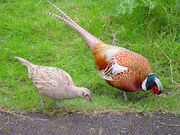(Created page with "thumb|Sexual Dimorphism is the difference in form between males and females of the same species. ==Definition== '''Sexual dimprphism''' is an...") |
No edit summary |
||
| Line 1: | Line 1: | ||
| − | [[File:Sexual_dimorphism.jpg|thumb|Sexual Dimorphism is the difference in form between males and females of the same species.]] |
+ | [[File:Sexual_dimorphism.jpg|thumb|Sexual Dimorphism is the difference in form between males and females of the same species.]] |
==Definition== |
==Definition== |
||
'''Sexual dimprphism''' is an observable difference in appearance between males and females in the same species. These differences can include variations in color, shape, structure and size. Sometimes the differences are extreme for example the male birds of paradise which exhibit large plumes of feathers with exotic colors. Another example would be a male lion with its large mane, and the female without. |
'''Sexual dimprphism''' is an observable difference in appearance between males and females in the same species. These differences can include variations in color, shape, structure and size. Sometimes the differences are extreme for example the male birds of paradise which exhibit large plumes of feathers with exotic colors. Another example would be a male lion with its large mane, and the female without. |
||
| + | ==Three Major Hypotheses Leading to Sexual Dimorphism== |
||
| + | Each of these hypotheses can operate in natural populations, and are therfore considered plausible: |
||
| + | #''Sexual Selection'' |
||
| + | *''''In species with larger males,it is observed that the males physcially compete with each other for a mate. |
||
| + | *Female preference for certain male size and morphologies. |
||
| + | |||
| + | |||
| + | 2. ''Dimorphic Niche Hypothesis'' |
||
| + | *Most studies are focused on selection pressures which act only on females. |
||
| + | *In species with females which are larger than males,the size correlation can be attributed to the need for females to produce and carry young. |
||
| + | *It issuggested that the larger the female, the more offspring, they can produce. Lifetime fecundity overall is also increased. |
||
| + | |||
| + | |||
| + | 3. ''Food Competition Between Sexes '' |
||
| + | *Sexual dimporphism is maintained during nonbreeding season based on food competition between sexes. |
||
| + | *Rates of energy intake among pairs shouldbe correlated based on territory quality, breeding timing and predation. This should also be compared with reproductive success. |
||
| + | |||
| + | |||
| + | Hedrick, A.V & Temeles, E.J.(1989). The evolution of sexual dimorphism in animals: hypotheses and tests. TREE, 4(5): 136-138. |
||
Revision as of 18:27, 17 November 2013

Sexual Dimorphism is the difference in form between males and females of the same species.
Definition
Sexual dimprphism is an observable difference in appearance between males and females in the same species. These differences can include variations in color, shape, structure and size. Sometimes the differences are extreme for example the male birds of paradise which exhibit large plumes of feathers with exotic colors. Another example would be a male lion with its large mane, and the female without.
Three Major Hypotheses Leading to Sexual Dimorphism
Each of these hypotheses can operate in natural populations, and are therfore considered plausible:
- Sexual Selection
- In species with larger males,it is observed that the males physcially compete with each other for a mate.
- Female preference for certain male size and morphologies.
2. Dimorphic Niche Hypothesis
- Most studies are focused on selection pressures which act only on females.
- In species with females which are larger than males,the size correlation can be attributed to the need for females to produce and carry young.
- It issuggested that the larger the female, the more offspring, they can produce. Lifetime fecundity overall is also increased.
3. Food Competition Between Sexes
- Sexual dimporphism is maintained during nonbreeding season based on food competition between sexes.
- Rates of energy intake among pairs shouldbe correlated based on territory quality, breeding timing and predation. This should also be compared with reproductive success.
Hedrick, A.V & Temeles, E.J.(1989). The evolution of sexual dimorphism in animals: hypotheses and tests. TREE, 4(5): 136-138.